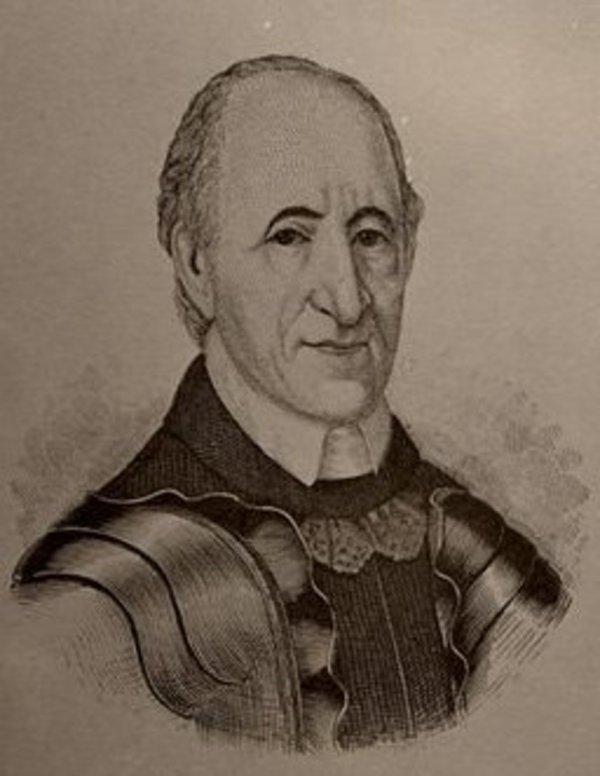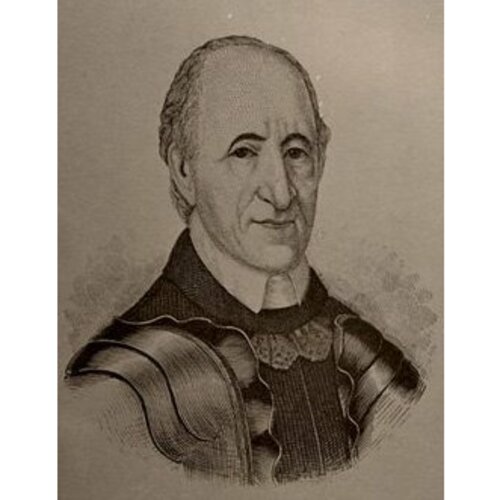
Source: Courtesy of Wikimedia Commons
COULON DE VILLIERS, FRANÇOIS, captain in the colonial regular troops; b. 1712 at either Montreal or Verchères (Que.), son of Nicolas-Antoine Coulon* de Villiers and Angélique Jarret de Verchères; d. 22 May 1794 at New Orleans, Spanish Louisiana.
François Coulon de Villiers was a member of a distinguished military family of the Canadian nobility. In 1733, while holding the non-commissioned rank of brevet cadet, which would indicate his having already had several years of military service, he was severely wounded in an encounter with a Fox war party near Baie-des-Puants (Green Bay, Wis.). His father, the district commandant, and a brother were killed in this skirmish. To compensate the family for their loss, his brothers Louis* and Nicolas-Antoine* were promoted second ensign and lieutenant respectively, and François was commissioned ensign on 15 Aug. 1736. In his report to the minister of Marine in 1739 Governor General Beauharnois* remarked that Coulon de Villiers was “a good officer, zealous for the service, [and] of a good conduct.” He was subsequently transferred to the Louisiana establishment and promoted lieutenant in 1746. While serving in the Illinois territory he was married twice: first to Élisabeth Groston de Saint-Ange, of Illinois, and secondly to Marie-Madeleine Marin of Fort de Chartres (near Prairie du Rocher, Ill.). He had one daughter by his first wife in 1740 and one son by his second in 1757.
On 1 Feb. 1754 Coulon de Villiers was commissioned captain. The same year, while England and France were still at peace, a detachment of Virginia militia led by George Washington ambushed a French emissary party commanded by François’s brother, Joseph Coulon* de Villiers de Jumonville, who was killed in the affray. During the ensuing hostilities François lost no opportunity to avenge his brother’s death. In 1756 he led a force of 23 colonial regulars and 32 Indians in an assault on Fort Granville (near Lewiston, Pa), some 60 miles from Philadelphia, captured it, took about 30 prisoners, burned the fort with its six months of supplies, and safely retired. The following year he was acting adjutant of Fort de Chartres and continued to lead war parties that ravaged the frontiers of Virginia. In September 1758 he was with the force that inflicted a defeat on Brigadier-General John Forbes*’s advance guard near Fort Duquesne (Pittsburgh, Pa). The tables were turned in 1759 when the Anglo-Americans laid siege to Fort Niagara (near Youngstown, N.Y.). A relief force from the Ohio garrison rushed to its aid and was cut to ribbons in an ambush. Among those taken prisoner was Coulon de Villiers. After being exchanged at New York for an English officer held by the French he made his way to New Orleans where he was awarded the cross of Saint-Louis on 1 Aug. 1759.
When Louisiana was ceded to Spain Coulon de Villiers resigned his commission in the French regulars, entered the Spanish service, and was appointed to the command at Natchitoches. On 28 June 1762 he married Marie-Geneviève Énault de Livaudais at New Orleans and acquired a plantation, most likely from her, at Pointe Coupée (near New Roads, La). In 1768, while he was serving at Natchitoches, the prominent Canadians of New Orleans rose in revolt against their Spanish rulers. The following year the revolt was sternly suppressed by 3,000 Spanish troops sent from Cuba. Probably in recognition of his not having participated in the uprising, Coulon de Villiers was appointed an alcalde of New Orleans, an important administrative and judicial post in the local government. He now took up residence in his wife’s commodious New Orleans house, tended by eight domestic slaves.
When he made his will on 18 Feb. 1794 Coulon de Villiers could look back on a distinguished career under two crowns. He had been fortunate to survive the wars and was fortunate also to die when he did. To have lived another decade and thereby come under American rule would have been bitter indeed for a nobleman who had named his youngest son Jumonville, in memory of the brother slain by George Washington.
AN, Col., D2C, 47, ff.688–89; 48, ff.38, 41; 49, ff.320, 326; 61, f.89. La. State Museum (New Orleans), Cathédrale Saint-Louis de la Nouvelle-Orléans, Registre des mariages, 28 juin 1762. Natchitoches Court Record Office (Natchitoches, La.), Conveyances, 5, f.826; 6, f.865; 10, f.1220; 11, f.1257; Spanish translations, 45, no. 1198. New Orleans Court Record Office, Greffe de François Broutin, 18 févr. 1794. New Orleans Public Library, Department of Archives, Census of New Orleans, 6 Nov. 1791. St Martin Parish Court House (St Martin, La.), Original acts, 1–15, 1760–94. G. R. Conrad, First families of Louisiana (2v., Baton Rouge, La., 1970), I, 170. Stanley, New France. A. [-E.] Gosselin, “Notes sur la famille Coulon de Villiers,” BRH, XII (1906), 174, 257–75.
Cite This Article
W. J. Eccles, “COULON DE VILLIERS, FRANÇOIS,” in Dictionary of Canadian Biography, vol. 4, University of Toronto/Université Laval, 2003–, accessed April 29, 2025, https://www.biographi.ca/en/bio/coulon_de_villiers_francois_4E.html.
The citation above shows the format for footnotes and endnotes according to the Chicago manual of style (16th edition). Information to be used in other citation formats:
| Permalink: | https://www.biographi.ca/en/bio/coulon_de_villiers_francois_4E.html |
| Author of Article: | W. J. Eccles |
| Title of Article: | COULON DE VILLIERS, FRANÇOIS |
| Publication Name: | Dictionary of Canadian Biography, vol. 4 |
| Publisher: | University of Toronto/Université Laval |
| Year of revision: | 1979 |
| Access Date: | April 29, 2025 |



